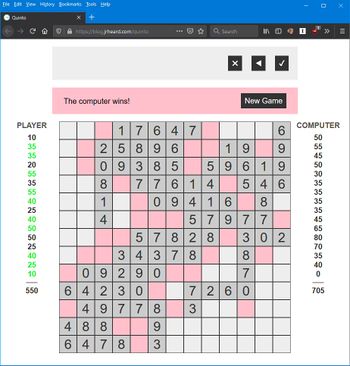Quinto (grid game): Difference between revisions
imported>Pat Palmer No edit summary |
imported>Pat Palmer No edit summary |
||
| Line 7: | Line 7: | ||
=== Editions of the board game === | === Editions of the board game === | ||
The original board game was sold in the 1960's by [[3M]] (as a "3M Bookshelf" game), and is no longer being manufactured. As of 2020, a lively online trade exists in old, used Quinto board games. There are two editions still being traded<ref>Per [https://boardgamegeek.com/thread/24859/tile-distribution this Boardgamegeek online post], there may have been | The original board game was sold in the 1960's by [[3M]] (as a "3M Bookshelf" game), and is no longer being manufactured. As of 2020, a lively online trade exists in old, used Quinto board games. There are two editions still being traded<ref>Per [https://boardgamegeek.com/thread/24859/tile-distribution this Boardgamegeek online post], there may have been an original wooden version from 1964 which used a 15 x 15 grid and had fewer (only 82 instead of 90) tiles.</ref>. | ||
==== 1964 edition ==== | ==== 1964 edition ==== | ||
| Line 26: | Line 26: | ||
==== 1968 edition ==== | ==== 1968 edition ==== | ||
The 1968 edition has 90 brown tiles and 5 red tiles<ref>Unfortunately, it is unclear how the five red tiles in the 1968 edition, called "multiles", are scored.</ref>, and a white board with 12 rows and 18 columns (one more than the 1964 game). Note that the number distributions in the two editions differs, as well as board size and the color and numerical distribution of the tiles. The numerical distribution for the | The 1968 edition has 90 brown tiles and 5 red tiles<ref>Unfortunately, it is unclear how the five red tiles in the 1968 edition, called "multiles", are scored.</ref>, and a white board with 12 rows and 18 columns (one more than the 1964 game). Note that the number distributions in the two editions differs, as well as board size and the color and numerical distribution of the tiles. The numerical distribution for the tiles in the 1968 edition was as follows: | ||
Brown Tiles : 90, distributed like the black tiles in the 1964 edition | Brown Tiles : 90, distributed like the black tiles in the 1964 edition | ||
Revision as of 13:10, 11 November 2020
- See also: Quinto (card game)
Quinto is a two-player board game, sometimes also called "Game of Fives". It's rules resemble those of Scrabble, except the tiles are numbers rather than letters. The vertical and horizontal total must always be a multiple of five, and five is the maximum tiles that can be in a contiguous run. Each play can be horizontal or vertical, but not both. The score of each play, as in Scrabble, is the sum of all numerical totals of each vertical or horizontal run created by the play.
Editions of the board game
The original board game was sold in the 1960's by 3M (as a "3M Bookshelf" game), and is no longer being manufactured. As of 2020, a lively online trade exists in old, used Quinto board games. There are two editions still being traded[1].
1964 edition
The 1964 edition had 90 black tiles, and a marble-gray board with 13 rows and 17 columns. The numerical distribution for the ninety tiles was as follows:
Tile : how many (90) 0 : seven 1 : six 2 : six 3 : seven 4 : ten 5 : six 6 : ten 7 : fourteen 8 : twelve 9 : twelve
1968 edition
The 1968 edition has 90 brown tiles and 5 red tiles[2], and a white board with 12 rows and 18 columns (one more than the 1964 game). Note that the number distributions in the two editions differs, as well as board size and the color and numerical distribution of the tiles. The numerical distribution for the tiles in the 1968 edition was as follows:
Brown Tiles : 90, distributed like the black tiles in the 1964 edition
Red Tiles: how many (5)
5 : one
6 : one
7 : one
8 : one
9 : one
Online game (since 2018)
In 2018, programmer J. R. Heard created an addictive online version of Quinto. Heard provided an "AI opponent" that is virtually unbeatable by humans, and also play hints that help a human increase their skills. The online game uses the 90-tile numerical distribution of the 1964 edition of the Quinto board game, but its board has four fewer vertical columns, making it a 13x13 grid. The game is powered by Javascript, which means it executes locally in your web browser and the game web page can be saved locally on your computer for offline use. The details about the source code are also online.
Notes
- ↑ Per this Boardgamegeek online post, there may have been an original wooden version from 1964 which used a 15 x 15 grid and had fewer (only 82 instead of 90) tiles.
- ↑ Unfortunately, it is unclear how the five red tiles in the 1968 edition, called "multiles", are scored.

